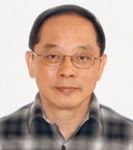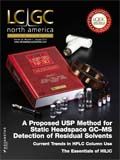Peaks of Interest
The 23rd International Symposium on Chiral Discrimination (Chirality 2011) was held in Liverpool, UK, this past July.
Meeting Report: 2011 Chirality Conference
Kevin A. Schug, associate professor, Department of Chemistry & Biochemistry, The University of Texas at Arlington
The 23rd International Symposium on Chiral Discrimination (Chirality 2011) was held in Liverpool, UK, this past July. This conference, which rotates each year between Europe, the United States, and Asia, is exceptional in its wide collection of disciplines related to the concept of stereochemistry: it covers topics related to separation science, spectroscopy, synthesis, supramolecular chemistry, and biological chirality. One can choose to see highlights of research in a specific area of interest, or learn something new by listening to talks in other fields. No more than two parallel sessions are typically held, so there is little chance of missing something of interest because it conflicts with another talk. The intimate size (typically 300–600 attendees) of the symposium ensures optimal social interactions to discuss research, make new and meet old friends, and form collaborations.
Highlights of the 2011 Conference
Each year the Chirality conference takes on a bit of specialized flavor based on its organizers. In Liverpool, the conference was organized by Professor John Caldwell from the University of Liverpool, who is editor-in-chief and a founder of the journal Chirality. He is well known for his many contributions to research in stereochemistry, and particularly for his expertise in the development of single enantiomer drugs. As expected, the conference heavily featured prominent invited speakers from industry and academia across Europe.
Professor Laurence Barron, Emeritus Professor of Chemistry at the University of Glasgow, received the 2011 Chirality Medal. Each year, the Chirality Medal is awarded to an individual who has made a particularly distinguished contribution to the field of chirality. The award is conferred the evening before the first full day of the meeting and is accompanied by a lecture by the awardee and a reception after the talk. Professor Barron delivered an excellent lecture on the topic of vibrational circular dichroism, a spectroscopic technique that he pioneered and developed, and which is now one of the premier methods for assigning absolute configurations of single enantiomers.

Michael W. Dong
From the United States, Dr. Christopher Welch, Senior Scientist at Merck (Whitehouse Station, New Jersey), gave a talk in which he implored the scientific community that developmental work is needed in the important field of chiral selectors, molecules that can selectively recognize and bind to one enantiomer form of a molecule over another. Chiral selectors are extremely important to the pursuit of single enantiomer drug compounds, particularly in the context of analytical and preparative liquid phase separation techniques. Welch surmised that much of the talent in modern asymmetric synthesis could be applied to the development of effective chiral selectors, but this has not yet been pursued to a sufficient extent.
These and other highlights contributed to a highly intimate and successful conference, which culminated in a charming conference dinner aboard the iconic Mersey ferry.
Preview of the 2012 Conference
In 2012, the Chirality conference will return to the United States. Professor Daniel W. Armstrong and I will organize the meeting in the historic city of Fort Worth, Texas — "the Gateway to the West" — from June 10 to 13. Consistent with the interests of the organizers and important efforts in chirality research, the meeting will place a significant focus on contributions in the areas of chiral drug development, enantioselective separations, and chiroptical spectroscopy. A special session will be dedicated to discussing considerations in the pharmaceutical industry, including the path of taking a new drug from discovery to market and the science behind prominent lawsuits involving chirality in drugs. There will also be sessions on chiral molecular recognition, computational chirality, and a particularly rich collection of talks on asymmetric synthesis and catalysis. Perhaps the biggest highlights are the two plenary lecturers slated for the conference. Professor E.J. Corey from Harvard University (Cambridge, Massachusetts), the 1990 Nobel Prize in Chemistry award winner, will speak about his exploits in enantioselective chemical synthesis. Also, Professor Ronald Breslow from Columbia University (New York, New York), a U.S. National Academy of Science member, will speak about the origin of chirality and life.
The numerous excellent presentations will be given amidst an informative short-course program, a poster symposium and award competition, and a vendor exhibition. Of course, those who come to Texas have to experience Texas. An outstanding social program is being planned, including trips to the historic stockyards for a rodeo and the conference dinner. Fort Worth is also well known for its many museums, the Bass Performance Hall, and its nightlife.
Abstracts for Chirality 2012 (www.chirality2012.com) will be accepted through March 15, and early registration ends April 15.
Michael W. Dong Joins LCGC's Editorial Advisory Board
LCGC is pleased to announce the addition of Michael W. Dong, PhD, to its editorial advisory board.
Dong is a senior scientist in the small molecule drug discovery group at Genentech (South San Francisco, California), a position he has held since 2007. He formerly served as a research director at Synomics Pharma (Wareham, Massachusetts), a research fellow at Purdue Pharma (Cranbury, New Jersey), a senior staff scientist at Applied Biosystems/PerkinElmer (Foster City, California), and a section head at Hoechst Celanese (Bridgewater, New Jersey).
Dong has conducted training courses at national meetings (ACS, Pittcon, EAS AAPS, HPLC) on high performance liquid chromatography (HPLC) in pharmaceutical analysis and drug metabolism and pharmacokinetics, HPLC method development, ultrahigh-pressure LC, the drug development process for scientists, and drug quality. His publishing credentials include more than 80 publications in chromatography and analytical chemistry. He has authored a bestseller in chromatography, Modern HPLC for Practicing Scientists (Wiley, 2006) and coedited Handbook of Pharmaceutical Analysis by HPLC (Elsevier/Academic Press, 2005).
Dong received his doctorate in analytical chemistry from the City University of New York (Albany, New York), and a certificate in biotechnology from the University of California, Santa Cruz.
Pittcon Award Winners Announced
The Pittcon 2012 program committee has announced the recipients of 11 awards that will be presented during a symposium at the conference.
The awards honor those scientists who have made outstanding contributions in the fields of analytical chemistry and applied spectroscopy.
The full list of winners and awards is as follows: Pittsburgh Analytical Chemistry Award, Alan G. Marshall, Florida State University; Pittsburgh Spectroscopy Award, W.E. Moerner, Stanford University; Pittcon Heritage Award, which honors Genzo Shimadzu, Sr. (1839–1894) and Genzo Shimadzu, Jr. (1868–1951), Shimadzu, Shijehiko Hattori, Shimadzu chairman of the board, will be accepting the award; Pittsburgh Conference Achievement Award, Christy L. Haynes, University of Minnesota; ACS Division of Analytical Chemistry Award for Young Investigators in Separation Science, Jared L. Anderson, University of Toledo; Bomem-Michelson Award, Joel M. Harris, University of Utah; Dal Nogare Award, Purnendu K. Dasgupta, University of Texas; Charles N. Reilley Award, Debra Rolison, Naval Research Laboratory; Young Investigator Award, Lane Baker, Indiana University; Ralph N. Adams Award, Jonathan V. Sweedler, University of Illinois; and Williams Wright Award, Richard Crocombe, Thermo Fisher Scientific.
The conference will run March 11–15, 2012 and will be held at the Orange County Convention Center, Orlando, Florida.
Agilent Instruments Play Key Role in Chemistry Department Upgrade
Agilent Technologies' instrumentation will be used in undergraduate teaching laboratories at Virginia Tech's department of chemistry (Blacksburg, Virginia). Approximately 7000 chemistry students a year will have access to seven new Agilent 5975C gas chromatography–mass spectrometry (GC–MS) systems, six 240FS atomic absorption spectrometry systems, a major upgrade to the department's nuclear magnetic resonance spectroscopy console, a 6100 series single quadrupole liquid chromatography–mass spectrometry (LC–MS) system, a Cary Eclipse fluorescence spectrophotometer, and a Cary 100 UV–vis spectrophotometer.
Professor Jim Tanko, chair of the Virginia Tech's chemistry department, said "This upgrade will enormously enhance the undergraduate laboratory experience for all students enrolled in chemistry classes — majors and non-majors. Virginia Tech will provide unprecedented, state-of-the-art facilities in support of undergraduate education. We are particularly excited that general chemistry labs for freshmen have been equipped with GC–MS equipment. We believe Virginia Tech is the first in the nation to offer this experience on such a large scale."
Bob Walker, Agilent regional manager, said, "Agilent is excited to be a part of this project. Virginia Tech's chemistry department is transforming science education by bringing students in contact with modern, industry-standard technology early in their academic experience. Also, thanks to Agilent's expanded portfolio, customers can now fully equip their laboratories with a complete suite of analytical tools from a single vendor and receive world-class products and support."
TNT-Absorbing Plants
A recent study has found three Caribbean plants that are not only resistant to high levels of trinitrotoluene (TNT) but can also completely remove it from aqueous media in under 48 h (1).
A team from the University of Puerto Rico-Mayaguez investigated the ability of Rubia tinctorum, Lippia dulcis, and Spermacoce remota to remove TNT. Plantlets of each were added to flasks containing solutions of TNT and samples were taken at timed intervals for HPLC analysis.
Rubia tinctorum and Lippia dulcis removed nearly 100% of the TNT from the medium, while Spermacoce remota completely removed TNT from the media in under 48 h. Part of the TNT was physically removed from the culture media by evaporation.
The main mechanism for removal is via adsorption through the roots, but once adsorbed Spermacoce remota works in a different way. Future work on this will be carried out to investigate the reasons behind this behavior.
TNT is a serious toxic contaminant and is present at both military sites and war zones around the world. More work also will be carried out using the plants in TNT contaminated soil, with initial results looking promising.
Reference
(1) S.N. Correa-Torres et al., J. Environ. Monit., DOI: 10.1039/c1em10602c (2012).

Extracting Estrogenic Hormones Using Rotating Disk and Modified Clays
April 14th 2025University of Caldas and University of Chile researchers extracted estrogenic hormones from wastewater samples using rotating disk sorption extraction. After extraction, the concentrated analytes were measured using liquid chromatography coupled with photodiode array detection (HPLC-PDA).
Polysorbate Quantification and Degradation Analysis via LC and Charged Aerosol Detection
April 9th 2025Scientists from ThermoFisher Scientific published a review article in the Journal of Chromatography A that provided an overview of HPLC analysis using charged aerosol detection can help with polysorbate quantification.
Removing Double-Stranded RNA Impurities Using Chromatography
April 8th 2025Researchers from Agency for Science, Technology and Research in Singapore recently published a review article exploring how chromatography can be used to remove double-stranded RNA impurities during mRNA therapeutics production.









